Social and economic development. Рубрика в журнале - Economic and Social Changes: Facts, Trends, Forecast
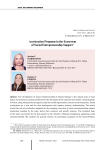
Acceleration programs in the ecosystem of social entrepreneurship support
Статья научная
The development of social entrepreneurship in Russia belongs to the topical areas of state policy and is aimed at creating conditions for the formation of the social services market, the participants of which, along with government agencies and non-profit organizations, become social enterprises. Social accelerators are a new tool for their development that requires systemic understanding. The article reveals the role of acceleration programs in the emerging ecosystem of social entrepreneurship support institutions initiated by the state, shows their common and specific features. The empirical basis of the study was formed by the data posted on the websites of Russian foundations supporting social entrepreneurship. We consider the general scheme of acceleration programs of the Social Projects Support Fund, Social Investment Fund, The Foundation of regional social programs “Our Future” and RAISE University Accelerator (RANEPA), including an analysis of the basic events organized for the participants of accelerators. This article presents systematized data on such interrelated elements of social acceleration as training, mentoring, partner and client networking, local community of social entrepreneurs, direct and indirect funding, and information support. The programs we analyzed followed the same pattern. They include a set of segments, each with a specific function for the development of promising social enterprises. We have identified the problems of exaggerated selection criteria for the acceleration cycle, the lack of direct financing as an element of Russian acceleration programs, which reduces the potential for participation of interested target groups, and weak information support for existing programs. Thus, the results of this study contribute to the study of the strategic advantages and limitations of social acceleration.
Бесплатно
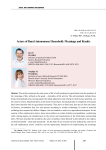
Actors of rural autonomous household: meanings and results
Статья научная
The article examines the main areas of life of self-employed in agriculture from the position of the meanings of life, defined as the goals - principles of life activity. The self-employed include those heads of households who, having passed the initial adjustment and relying on their human potential, use the reserves of new household forms in the local environment, having partially or completely terminated their labor relations with an agricultural enterprise. They have no farm land, they do not have the status of farmers, nevertheless they live and operate according to similar technology. In terms of material wellbeing they surpass their fellow villagers, who are limited to work in an agricultural enterprise. In the context of free employment choice, these actors adhere to certain attitudes and guidelines, conforming (with varying degrees of completeness) to the norms and requirements of the institutions surrounding them. We have described the problems that arise in families whose lifestyle is determined by the objects of their household - plant and animal life. On the basis of our research we have defined the contours of the self-employment actors' creativity and the opportunity limitations of implementing the meanings of household, which is explained by the violation of conjugations in interaction with large agricultural entities, destruction of connections and relations in the production and sale of products. We have found that depending on the changes in a family life, with the transformation of such indicators as age, health, achievement of ultimate goals (for example, the completion of children's education in universities or, on the contrary, their return to the village), the head and family members constantly cross the formal and essential boundaries of the pre-established status, the scale of activity and, in general, the space mastered and not mastered by them. The study of the social experience of autonomous family household contributes to a deeper comprehensive understanding of the deployment of modernization in the village in the context of the conjunction of innovative and traditional trends.
Бесплатно
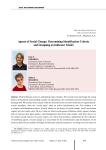
Agents of social change: determining identification criteria and designing an indicator model
Статья научная
Modern Russian society is undergoing major changes. The concept of social change has a long history of theoretical understanding; usually, two approaches, the evolutionary and the revolutionary, are distinguished. We consider this concept within the framework of a new post-modernist or organizational-activity paradigm, when the “social agent” plays an active transformative role. The problem is of a complex interdisciplinary nature, directly related to the theory of social change, social and human capital, and the creative class. We try to find out which social groups of Russian society support changes and can become their agent-guides, what distinguishes them from other people, what their share is in the modern social structure of society, region, city. The article provides a justification for the relevance of identifying agents of social change as a social basis for the transformation and development of the territory. Based on the analysis of foreign and domestic research experience, we design our own notion of For citation: Vorobeva I.N., Mekhova A.A. (2022). Agents of the term “agents of social change”, define the criteria for their identification, create an indicator model for empirical identification of the share of agents of social change in the social structure of the urban community. Theoretical judgments and conclusions are supported by empirical data from a sociological survey of Cherepovets residents. The choice of the city for approbation of the model is not accidental. Cherepovets has the status of a territory of advanced socio-economic development and is in dire need of agents of social change. According to an empirical study, in Cherepovets the core of social change is 4.6%, and the periphery of the core, which we designate as activists, is 17.4%. A comparison of the empirical results of our study and studies of leading Russian authors on the topic of social participation shows that Cherepovets, on average, reflects the general trend in Russia. The population as a whole has rather pronounced attitudes towards activity, while the behavioral practices expressed in our model in various forms of social participation are lagging behind significantly. We prove the validity of the developed model for studying the stated problem and empirically confirm that the development potential of the territory is largely determined by the presence of agents of social change in the social structure.
Бесплатно
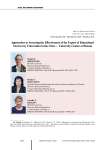
Статья научная
The export of education in Russia was officially proclaimed as a priority area of governmental policy in 2017. The subsequently adopted documents such as the project “Development of the export potential of the Russian education system”, the program “Priority 2030”, and the national project “Science and universities” confirm that the export of education remains an important governmental strategy, despite the changed geopolitical context. The export of education is considered in the works of scientists from Russia and other countries: they study in detail the economics of education export in various countries, adaptation of foreign students, methodological approaches, legal and visa systems of educational migration, etc. The aim of our work is to develop a methodology for evaluating the effectiveness of the export of education by universities in the cities - university centers of Russia and test it on the materials of the Siberian Federal District. Despite a wide range of relevant publications that we arranged in six main groups, these aspects have not been the subject of scientific analysis. We have developed our own system of indicators and indices (a comprehensive indicator of the effectiveness of the export activities of universities in the cities - university centers, calculated on the basis of indices of the educational and research potential of universities’ export activity). The methodology has been tested on the indicators for 115 universities and 30 cities - university centers of the Siberian Federal District. We have revealed that the data are scattered: out of 29 cities where foreign students study, only Tomsk is in the group of cities with high potential for educational and research export activities. The majority of the cities - university centers (22) belong to group 3 - with low potential for educational and research export activities. Our research makes it possible to comprehensively assess the effectiveness of the export of educational services by universities and cities - university centers in each group and set out the priorities for the development of universities; and also identify cities that best meet the needs of the country to implement the export of education.
Бесплатно
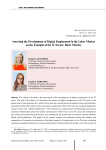
Статья научная
The article is devoted to the assessment of the development of digital employment in the IT sector. The aim of the study is to determine the metrics of digital employment in the IT sector in the gender and territorial perspective, which can be used for monitoring the development and comprehensive assessment of the labor market in the area under consideration. We provide our own understanding of the essence of the term “digital employment”. The research was conducted by benchmarking and content analysis of information about the supply and demand of labor force in the IT sector; the information was retrieved from Russian government and commercial job search and recruitment websites (Rabota Rossii and HeadHunter). The subject of the content analysis was information about the number and composition of vacancies and resumes in the digital segment of employment in the IT sector, including vacancies containing references to remote working hours, both overall in the sample, and in the context of gender and industry. The content analysis covered vacancies and resumes in all federal districts: Central, Northwestern, Southern, North Caucasian, Volga, Ural, Siberian and Far Eastern. The results were used to calculate the structure of professional qualifications, to identify gender specifics and general trends in the development of digital employment in the IT sector, both on average in the country and in the federal districts. The analysis of information on the demands of the labor market participants in the area under consideration allowed us to conclude about the asymmetry of supply and demand. In order to assess the development of the market for professional qualifications in the IT sector, the metrics of digital employment were identified, which help to evaluate its quantitative and qualitative characteristics, including in the gender and territorial perspective. The research results can further be used in monitoring the development and comprehensive assessment of digital employment in the IT sector, and also serve as the basis for the development and implementation of state policy programs to regulate digital employment in the labor market of the IT sector.
Бесплатно
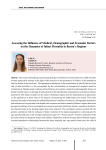
Статья научная
The issues of identifying and assessing the degree of influence of various factors on child mortality become particularly relevant in the light of the reduction in the proportion of children in the population and the decline in the birth rate. The quantitative assessment of the contribution of specific factors to the risk of child mortality is a key prerequisite for the substantiation of management measures aimed at minimizing it. Despite ample evidence of the influence of economic, medical and demographic factors on people’s health, there is a shortage of works devoted to the identification of quantitative correlations of these parameters with infant mortality in the context of Russian regions and the substantiation of approaches to the application of these tools in the practice of improving the child health care system. This study presents the results of assessing the relationship between a number of economic, demographic parameters and indicators of the provision with health care resources and infant mortality. Russia’s regions have been grouped according to the level of health care resources provision (bed fund, doctors, outpatient facilities), the characteristics of the leading regions have been analyzed. The correlation analysis revealed that the greatest correlation with the indicator of infant mortality of the regional population is demonstrated by age-specific birth rates in the youngest reproductive ages (15-19 years and 20-24 years), indicators of the provision of beds for pregnant women and children. Regression analysis of panel data for Russian regions revealed quantitative relationships between the infant mortality rate, age-specific birth rates, the value of gross regional product and the health care resources provision. The results of the study may be of interest to specialists in the field of regional child health care.
Бесплатно
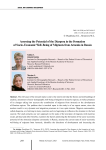
Статья научная
The relevance of the research topic is due to the need to develop the theory and methodology of analysis, assessment of socio-demographic well-being of migration-attractive regions, as well as prospects of its changes taking into account the contribution of migrants from Armenia to the development of Russian regions. The problem that is touched upon in the study is of an urgent nature, since the modern world is very dynamic and migration processes in it are quite intense. Migrant communities, called diasporas, are forming in many countries and are beginning to influence the situation in the host country. The study presents our own approach to the study of the provision of migrants with material, social, spiritual and other benefits, examines the factors promoting the formation of the socio-economic potential of the Armenian diaspora community in Russia, assesses the current state of socio-economic well-being of migrants from Armenia, identifies the directions of development and increasing the efficiency of the use of the socio-economic potential of migrants. Special attention is paid to the analysis of the peculiarities of migration processes in Russia and Armenia as a form of economic activity of communities in foreign cultural spaces. The scientific significance of the study is due to our contribution to the theoretical understanding of the phenomenon of socio-economic well-being of migrants, enriching the theory with empirical data that allows us to define the features and stable trends of the transformation of labor migration, its impact on socio-economic processes in Russia and Armenia. We note that getting into a new social environment and trying to adapt to it, representatives of ethnic groups either occupy free zones in the national economic system, or adopt their own forms of economic activity associated with their ethno-cultural traditions.
Бесплатно
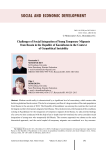
Статья научная
Modern social reality is characterized by a significant level of uncertainty, which creates risks both in a global and local context. This led to a temporary outflow of a large number of the male population from Russia in the autumn of 2022. The Republic of Kazakhstan was among the countries that received the largest number of temporary migrants from Russia. The article presents a brief analysis of the conditions existing in Kazakhstan for the integration of temporary migrants from Russia; we also provide findings of a survey we have conducted with the help of an in-depth interview method; the survey considers social integration of young men who temporarily left Russia. The resource approach was chosen as the main theoretical approach, and the social capital of temporary migrants was considered as a key resource. To address the research tasks, we conducted 20 in-depth interviews with temporary male migrants from Russia who had arrived in Kazakhstan. As a result, we have revealed that social capital plays a significant role in the social integration of temporary migrants. First, the formation of new ties contributes to the formation of a community of migrants from Russia, which is supported by mutual assistance practices. Second, the accumulated social capital in the transnational social space allows temporary migrants to receive assistance from the country of origin, which greatly simplifies the integration process. Third, the social capital formed in the offline and online space is actively transformed from one form to another, which helps to address migrants’ issues in the process of social integration. However, a lack of financial and personal resources in the first place can hinder successful social integration in a new environment.
Бесплатно
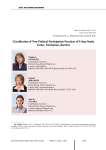
Classification of non-political participation practices of urban youth: forms, motivation, barriers
Статья научная
The article explores civic (non-political) participation practices among young people, which are understood as voluntary, public, and altruistic individual or collective actions. They are viewed as a condition for allowing young people to exercise their right to the city and are aimed at transforming urban space. The role of citizens in modern urban centres is increasing; they are becoming not only users, but also co-authors. Local activities that transform the territory in which young people live lead to an increase in their self-esteem and confidence, the acquisition of soft skills, and the formation of norms of interpersonal interaction. This study's main aim is to identify types of youth civic participation in a large industrial city. Drawing on data from an online survey (quota sampling, n = 800) of young people in the large industrial city of Yekaterinburg (Russia) conducted at the end of 2020, we suggest a typology of civic participation practices. The types were identified through the experience of participation in activities aimed at exercising a right to the city, a willingness to collaborate with other people, the degree of the institutionalisation of civic practices, and motivation to participate or not participate in civic practices. The article argues for building a constructive dialogue with government authorities to meet the needs of young people in transforming urban space. Studying specific do-it-yourself urban design practices in different cities and territories to find the most successful models for potential replication may be a promising direction for further research.
Бесплатно
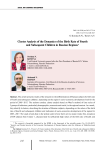
Статья научная
The article presents results of the research in the differentiation of Russian subjects by birth rate of fourth and subsequent children, depending on the region's socio-economic development level for the period of 2005-2017. The authors conduct cluster analysis based on Ward's method of time series of 3 groups of indicators, particularly demographic, economic and social, in the regional context. As a result, they identify 6 clusters, describing the situation of Russian subjects, depending on the values of the birth rate of fourth and subsequent children and indicators of socio-economic development of the region for 2005-2017. The study reveals that in the period under review there are two main trends: first, transition of RF subjects from Cluster 1, characterized by sufficiently high values of the birth rate of fourth and subsequent children and low indicators of socio-economic development, to the clusters with a lower value of the coefficient and higher indicators of socio-economic development; second, transition of RF subjects from the clusters with a low birth rate of fourth and subsequent children to the clusters characterized by the increased birth rate against the background of improved socio-economic development. In the current period, it is possible to distinguish the formation of two poles of large families - these are “the poor with many children” regions, in which a high birth rate of fourth and subsequent children is associated with low socio-economic development, and “the rich with many children” regions with high birth rates and a high level of socio-economic development. Between them there are other RF subjects, which are gradually moving away from the pole of “the poor with many children”, but have not approached the pole of “the rich with many children” yet. The novelty of the study lies in the application of the author's approach to the analysis of relationship between large families and socio-economic development of Russian regions in the temporal dimension.
Бесплатно
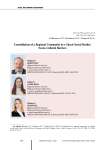
Consolidation of a regional community in a glocal social reality: socio-cultural barriers
Статья научная
The article is devoted to the problem of socio-cultural barriers to the consolidation of a regional community in the context of rising glocalization trends and an increasing role of regions in social development. In our opinion, consolidation in an unstable social reality can only occur as a regulated nonlinear process, oriented toward establishing strong interpersonal and intergroup communication, mutual trust and loyalty. The purpose of the research is to analyze socio-cultural barriers to regional community consolidation, associated with the specifics of value-normative complexes and attitudes of its constituent actors. We assess people’s dispositions concerning the problem of socio-cultural constants renovation on the basis of a sociological research we conducted in the Belgorod Oblast in 2021. It included a mass questionnaire survey (n = 500), an expert interview (n = 30), three focus groups. It is noted that social consolidation can be based on various grounds, but the most solid among them is sociocultural consensus expressed in integration based on common values, social norms, behavior patterns and attitudes - socio-cultural constants that represent a kind of reference points for consolidation process. We analyze components of the value-normative consensus and conclude that its potential as an attractor of the consolidation process can be realized mainly at the microsocial level (primarily family and family-related environment), which significantly restricts the integration opportunities of the regional community. According to the results of sociological diagnostics we reveal the following barriers to the social consolidation of a regional community: fragility of the value-normative consensus, lack of full-fledged regional identity, insufficient focus of authorities and civil society institutions on creating favorable organizational and technological conditions for social conjunction. We emphasize that the implementation of any consolidation strategy at the regional level must necessarily take into account these barriers and provide for measures aimed at their minimization.
Бесплатно
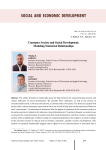
Consumer society and social development: modeling statistical relationships
Статья научная
The article attempts to empirically assess the links between the consumerization process and various indicators of social development. We consider these indicators, as well as the process of consumerization itself, at the macrosocial level, as characteristics of societies. The latter are equated with nation-states, whose sovereignty turns each of them into a kind of long-term social experiment. Based on such “experiments”, we attempted to determine how the degree of expansion of the consumer society in the same countries is related to the indicators of social development. To achieve this goal, we analyze ways to measure the consumerization of societies and their social development, and then conduct a correlation analysis of the available data. It allows testing two competing hypotheses: the negative or positive impact of the consumer society on aspects such as freedom, education, equality, security and happiness. This analysis of statistical relationships suggests that a higher level of consumerization is associated with a higher level of social development, at least on some indicators, such as the level of freedom, gender equality, and subjective well-being. The correlation with these indicators persists even after adjusting for per capita GDP. The presence of statistically significant stable links with social development and the absence of any links with social degradation allows drawing a preliminary conclusion about the refutation of the basic hypothesis of the consumerism criticism and the confirmation of its proponents’ correctness. However, our analysis confirms the connection between consumer society and social development, based on data in a sense formatted by consumer society itself. Therefore, for the final verification of competing hypotheses, it is necessary to develop new, critically oriented quantitative indicators of social development.
Бесплатно
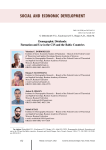
Demographic dividends: formation and use in the CIS and the Baltic countries
Статья научная
The article investigates one of the most pressing problems of the modern world - demographic aging and its impact on demographic security in the CIS. Changes in the age structure are happening on a global scale, and show increasing dynamics. At the same time, demographic aging has significant regional differences. The purpose of the study is to identify general trends, regional differences in population aging in the post-Soviet countries, the formation and use of demographic dividends. When analyzing the second demographic dividend, we propose to apply the term “resource potential of the older generation” that largely determines the capabilities of the aging population. We use the following methods: logical analysis, synthesis, generalization, induction and deduction, a systems approach to the analysis of demographic phenomena, calculations of demographic coefficients used in assessing the age structure, its dynamics and the formation of demographic dividends. The information base of the study includes data of the current accounting of demographic events presented by the Statistical Committee of the CIS, materials of Eurostat, the UN, domestic and foreign scientific publications, as well as materials of own research on the topic of the article. The main results of the work confirm the conclusion that the post-Soviet countries have significant differences in the age structure of their population and the intensity of demographic aging. We determine that the acceleration of the aging process was a general trend in most of them. This brings to the fore the problems associated with the need to form and effectively use the second demographic dividend, which will promote economic welfare of the countries.
Бесплатно
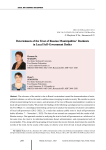
Determinants of the trust of Russian municipalities’ residents in local self-government bodies
Статья научная
The relevance of the article is due to Russia’s orientation toward the democratization of socio-political relations, as well as the need to address issues emerging in modern society. We consider a system of factors determining the level, nature, and dynamics of the trust of Russian municipalities’ residents in local self-government bodies. We provide the findings of the following sociological surveys conducted in the Tver Oblast: 1) a sociological monitoring carried out to analyze the dynamics of citizens’ perceptions of local self-government (2012-2022); 2) a study that analyzes public trust in local self-government bodies (October 7 - November 1, 2022). The data of our research are compared with the results of all-Russian surveys. Our approach consists in analyzing the trust in local self-government as a whole and, at the same time, the trust in its individual institutions (head, administration, and representative body of municipality). This, along with the grouping of trust factors that we put forward, determines the scientific novelty of the work. In the course of the study, we observe a low level of trust in local self-government bodies (compared, for example, with trust in the president), its undulating dynamics, predominance of an increasing trend, tendency toward its depersonalization, and formation of an institutional type of trust. We propose a theoretical and methodological framework for designing a system of determinants of trust in local self-government bodies and identify groups of factors influencing it. We reveal a weak connection of the dynamics of trust in local self-government bodies with the stages of the economic cycle, the importance of the material well-being of citizens as a trust factor; besides, we find that citizens’ trust in local self-government bodies is conditioned by their perception of the economic situation. The factors that have the most significant influence on the growth of the level of trust in local authorities include positive assessment of the work of local self-government bodies, citizens’ positive assessment of their own experience of interaction with local self-government employees, high or average assessment of the degree of influence of an ordinary citizen on the activities of local self-government bodies. Perceptions concerning the presence of corruption in municipal bodies, inconsistency of real municipal practices aimed at minimizing the participation of citizens in managerial decision-making, and people’s expectations have a negative impact on the credibility of this institution. We propose ways to solve these problems. Theoretical significance of the work is determined by the possibility to use the theoretical and methodological framework for further theoretical and empirical research. Practical significance is associated with the possibility of developing state and municipal policy measures aimed at improving ways to increase public trust in local authorities.
Бесплатно
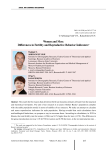
Differences in Fertility and Reproductive Behavior Indicators
Статья научная
The search for the reasons that determine birth rate dynamics remains relevant from the practical and theoretical viewpoints. The aim of our research is to assess whether Russia’s population complies with the stable population model in terms of stability of sex structure. We make an attempt to calculate and assess reproduction indicators for male population. Having revealed that such calculations have methodological limitations, we propose a way to overcome them. According to calculations, in 2019 in Russia, the total fertility rate for women (1.504) was 9.1% higher than for men (1.378). The difference in the gross reproduction rate was 3.1% (0.730 for women and 0.708 for men), in the net reproduction rate – 6.0% (0.719 for women, 0.678 for men). The difference in the value of the rate of natural increase in women and men is 5.0% (-11.5 and -12.1%, respectively). Due to the presence of two quantitatively different reproduction modes in the female and male generations, we doubt it would be possible to implement a stable population model. The age-related model of fertility in men, as well as in women, is shifting toward older ages (in the groups aged 25–29 and 30–34). The average age when men become fathers has also increased: from 31.51 years in 2011 to 32.40 in 2019. We also analyze the fertility rate model according to the age of the mother and father. We have determined that in most cases (70% in 2019) the father is older than the mother, in 19% of cases the mother is older than the father, in 11% – both parents are of the same age. Fathers are 1–4 years older than mothers in 44–64% of cases (depending on the age of the mother). It is noteworthy that the difference in the age of parents is higher when children are born out of wedlock. In the future, we find it interesting to study gender-related differences in reproductive motivation and other determinants of male and female fertility.
Бесплатно
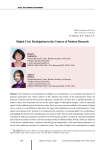
Digital civic participation in the context of modern research
Статья научная
The emergence and development of digital civic participation is an inevitable consequence of Internet penetration into various spheres of life. Despite the novelty of the phenomenon itself, the practices of online activism have become engrained in public life; and they have a significant impact on certain events, and sometimes even act as the main trigger of subsequent changes, which is especially typical of the political system. At the same time, there are many concerns related to the spread of digital civics, so that it is very difficult to talk about the long-term implications of such transformations. In this regard, the purpose of our research is to summarize the experience of studying digital civic participation and highlight the features of its manifestation in a modern world. The research methodology is based on the principles of making a systematic scientific review. During the analysis, we identify essential foundations and distinctive features of online activism compared to the traditional offline format, which are reflected in the forms of manifestation, methods of attracting and composition of the participants themselves, as well as the conditions necessary for collective action. The scope of digital civic participation is largely ensured by the ease of entry into public affairs, and the variability of activities and types of networking. Despite the prevalence of the thesis about the purely external visibility of online activism and its destructive consequences, specific empirical studies do not confirm this conclusion. Nevertheless, the threats of the spread of ICT are quite real and go far beyond the virtual space. In conclusion, we formulate several polemic provisions on possible ways to overcome the contradictions in this area. Our research contributes to the development of scientific ideas about the specifics of digital civic participation and the disclosure of the potential of its application from the standpoint of modern challenges and threats.
Бесплатно
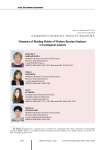
Dynamics of reading habits of modern Russian students: a sociological analysis
Статья научная
The features of reading habits and their transformation are the subject of interdisciplinary scientific analysis, as well as of a broad public discussion about the effective response of the Russian state to the challenges of a technogenic society. The areas of sociological reflection on this phenomenon are quite broad, such as the reading crisis, interest in books, the impact of globalization, e-books and other electronic formats for reading. Sociological analysis allows finding answers to questions about the state and features of reading habits as a component of social capital, the social quality of specific geographical, social and demographic groups. Bookishness (love and respect for books) is an important feature of the Russian mentality, an indicator of socio-cultural continuity, which is why the study of reading habits of modern Russian students' culture acquires particular relevance. This article presents the results of a sociological research conducted in Astrakhan and Volgograd (2016, 2019), as well as in Moscow (2019). These empirical studies provide insights into the main trends in the dynamics of the reading habits of modern Russian students, and help to conduct a comparative analysis of these habits of Russian cities' students, among other things in terms of socio-cultural space levels (the “core - periphery” coordinate system). We identified the dominance of the axiological component of reading habits; determined that classical literature is the basis of the content structure of reading; noted that the frequency of reading habits falls with decreasing population of the settlement - people read more in Moscow, less in the province. We think it would be promising to use the results and conclusions in monitoring studies and sociological projects on similar topics in other regions, and to continue studying the obtained results in the framework of interdisciplinary analysis.
Бесплатно
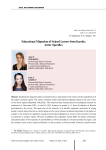
Educational migration of school leavers from Karelia: arctic specifics
Статья научная
Studying the migration plans of school leavers is important in the context of the reproduction of the region’s human capital. The article considers youth’s educational migration plans in the case of one of the Arctic regions (Republic of Karelia). The empirical base includes data of sociological research we conducted in November 2022. A total of 3,053 students in grades 8-11 from all districts of Karelia participated in the survey. The main aim of the research is to identify migration intensions of young people, namely school leavers as a social group on the way to choose vocational education in the region or outside it, the reasons for migration moods and potential willingness to return to the area after receiving a profession in another region. We have established that migration moods differ by regions of Karelia: educational plans of the majority of schoolchildren in Petrozavodsk are oriented outside the region, and the northern (non-Arctic) region of Karelia, on the contrary, to Petrozavodsk. However, school leavers of Arctic and southern regions are also focused on studying outside the region, where the flows from the regions are usually directed to the center of their region and then to other regions. It is important to assess the potential return of graduates who leave the region: most of those who are not going to study in Karelia are also going to work there. A comparison of actual and potential outflows of eleventh-graders from the region proves that in fact every third graduate leaves. Most graduates, disposed to leave, romanticize their plans, and only one in four families financially prepare for their child’s education in another region; the rest take no concrete action. The results obtained contribute to studying youth’s migration activity in Russia’s regions that are partially included in the Arctic zone of the Russian Federation, as detailed information is limited for such territories. In practical terms, the research results can form the analytical basis for the timely development of management mechanisms to strengthen and retain youth in the Arctic regions.
Бесплатно
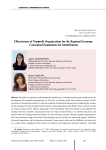
Статья научная
We make an attempt to substantiate the significance of creating institutional conditions for the development of nonprofit organizations; to this end, we identify social and economic impact of their activities on the regional economy. Using the synthesis of theoretical approaches to explaining the reasons for the emergence of the nonprofit sector (theory of interdependence and failure theory) and the results of content analysis of the projects supported by the Presidential Grants Foundation and submitted by socially oriented nonprofit organizations from the Volga Federal District, we identify directions and specify forms of leveling government failures. It was found that socially oriented nonprofit organizations focus on providing a range of services in the education system, health care and social support, which are of priority importance for the formation of people’s basic needs, which can be fulfilled by the state only to a certain limit, regardless of the territory of residence and taking into account residents’ individual needs. When assessing the effectiveness of their own work, representatives of socially oriented nonprofit organizations focus on its social significance, using mechanisms of point solutions to the current problems of the target audience. We identify the range of potential socio-economic effects from the activities of socially oriented nonprofit organization carried out on a systematic and long-term basis in the context of priority areas of their work. We emphasize that our approach, due to the formation of a unified view among economic agents (government, business, society and nonprofit organizations themselves), expands the idea of its importance for the region’s economy and may become a starting point for the creation of institutional conditions for the development of nonprofit organizations in Russia. The prospects for our future research include modeling the management system of specific regions of the Russian Federation based on the creation of institutional conditions to increase the contribution of socially oriented nonprofit organizations to the balanced development of territories.
Бесплатно
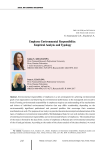
Employee environmental responsibility: empirical analysis and typology
Статья научная
Environmental responsibility of employees is a key prerequisite for achieving environmental goals of an organization and improving its environmental performance at the managerial and executive levels. Forming environmental responsibility in employees requires an understanding of the mechanisms and drivers of individual environmental behavior that may differ considerably, depending on the environmentally significant professional and personal qualities that encourage their conscious manifestation at work. The purpose of our study is to provide theoretical and empirical substantiation of the types of employee environmental responsibility. Methodological basis for our work includes the concept of individual environmental responsibility and environmental behavior of employees. The empirical base of the study is formed by the data from a survey of employees at Russian pro-environmental enterprises of the oil and gas industry. According to the results of the cluster analysis of the data obtained, we reveal characteristics for the role models of environmental behavior and identify four types of employees: ecoconservatives, eco-pragmatists, eco-activists, eco-pro-activists, differing in the awareness and acceptance of the company’s environmental values, compliance with environmental requirements in work activities, interest in participating in additional environmental activities and initiative in addressing environmental issues. The results obtained can be used to study the nature of individual environmental behavior and environmental responsibility; they can be also useful for companies in developing and improving human resource management policies and practices aimed at employees’ environmental development. The main limitation is the fact that we have chosen major oil and gas industry enterprises as the object of research, and they have a highly developed environmental policy, environmental management and the practice of environmental development of personnel; this narrows the significance of the results obtained within one industry, not allowing us to draw generalized conclusions and give practical recommendations.
Бесплатно

